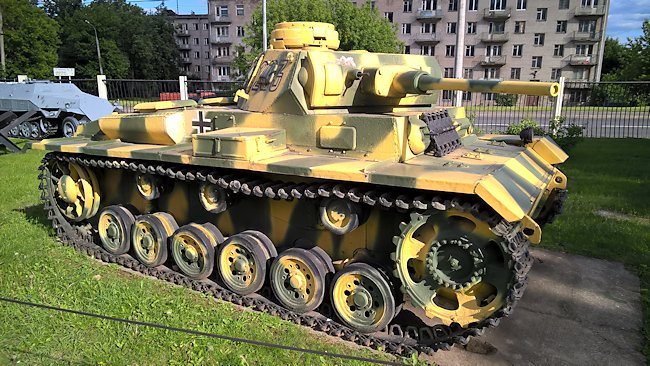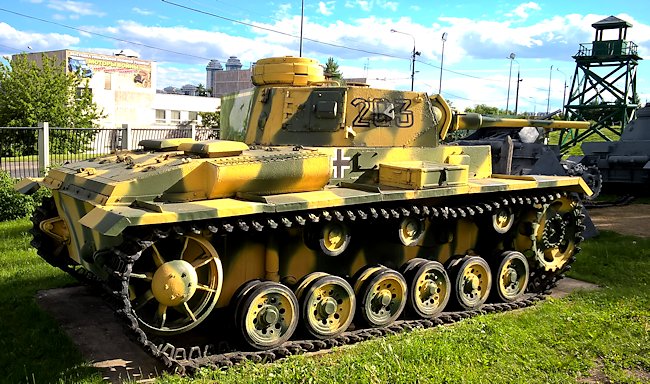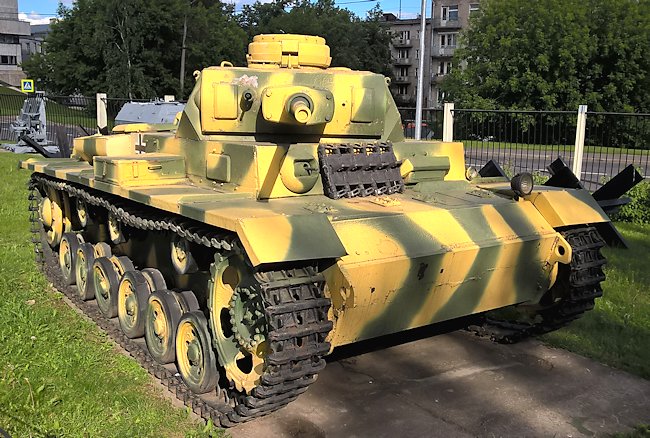The Panzer III Ausf. J
This German Panzer III Ausf J Tank is preserved at the Central Museum of the Great Patriotic War 1941 - 1945, Park Pobedy, Moscow, Russia. It is made from parts of different vehicles. The lower hull is from a StuG III and the upper hull is from a PzKpfw III Ausf.J with a barrelled 50 mm KwK 38 L/42 gun.

German Panzer III Ausf. J on display at the Central Museum of the Great Patriotic War 1941 - 1945, Moscow
Location
To get to the Central Museum of the Great Patriotic War 1941 - 1945, Park Pobedy in Moscow you will find it in the road called Kutuzovsky Ave in the west of the city. The nearest metro station is Park Pobedy. The tanks are kept in an outdoor section to the left of the main museum building, as you look at the entrance. Follow the signs to the 'War Weaponary and Fortification' exhibit. There are no tanks in the main museum.
Specifications
It was armed with a 50 mm KwK 38 L/42 gun. It had two 7.92 mm Maschinengewehr 34 machine guns:one next to the main gun in the turret and another in the hull. The five man crew were protected by armour that ranged from 10mm to 50 mm. It weighed 23 tonnes and was powered by a 12-cylinder Maybach HL 120 TRM giving a top speed of 40 km/h (25 mph) and a range of around 150 km (93 miles).

German Panzer III tank has only six track road wheels where as the Panzer IV has eight.
Panzer III Platoon Commander's Account
Rudolf Behr (31 December 1916 – 23 July 1943) was a highly decorated officer in the Wehrmacht during World War II. As a Lieutenant in 1938 he participated in the German invasion of Poland and later in the 1940 invasion of France campaign as a platoon commander.
Most early 1940 German Panzer Regiments were composed of four Panzer Abteilungs (tank battalions). Each Panzer Regiment as well as each Panzer Battalion had its own commander. Each Panzer Battalion normally had three companies. As an example of their structure, the 1st company was equipped with five Panzer IV tanks and ten Panzer I and II light tanks. The 2nd and 3rd company were equipped with five Panzer III tanks and seventeen Panzer I and II light tanks. The panzer I and II tanks, when possible were replaced with Panzer III and IV tanks as they arrived from the factory.
What follows is the translated war diaries of Oberleutnant Rudolf Behr: - The advance continues, as inexorably as ever. A glance at the map tells me that we are approaching a small town, Nesles-Neufchatel. We have already reached the first houses. A long street is just opening up in front of us, when we see the flash of fire from a gun barrel.
In a split second we are ready to fire. The tank stops, our shot is fired, and the shell hits home, tearing a hole in the protective shield of a French 7.5cm (3 in) howitzer. Movement is still visible around the gun. A second shot falls among the crew. The third shell is a glorious direct hit to the muzzle of the gun. The barrel is split, and the howitzer is out of action.
We are getting close to the town centre, a fairly large open space where five streets converge. There seems to be something going on up ahead! There are vehicle roadblocks , Frenchmen running around, and some firing from street openings. While our lead tank, Jochen 11, maintains all-round protective fire, I target another French 7.5cm (3in) howitzer. I can only wonder once again at the effectiveness of our HE explosive shells. If well aimed, the first or at most the second will achieve the desired effect completely.

The German Panzer III tank was armed with a 50mm gun
The lead tank has now advanced into the open space, and is halted there firing; my tank is about 10 metres (11 yards) behind him and ranged a little to one side in order to keep its own field of fire clear. My gunner has just managed to set two small armoured Renault tractors on fire, when suddenly all hell breaks out on the crossing. There is shooting from the left, puffs of smoke on the right and gun muzzles flashing straight ahead. Where to fire first?
Where are they hiding, those little well-camouflaged French anti-tank guns? There is no time for thought. While I am feverishly searching out the enemy guns, I see a small cloud of dust and smoke breaking out on the tank ahead. That was a hit! A second later the hatches open. The tank commander struggles out, falls across the hull on to the tarmac, and lies there. Two other crew members leap out and run behind my tank.
The tank commander, apparently wounded, drags himself to a house to seek cover. The next instant, a hard metallic blow strikes my tank, and in the crew compartment there is a display of sparks like a fireworks rocket. The driver is sitting below with his head falling forward. In the half-light, still blinded, I can see that there is blood running down his face. There is nothing for it but to get out.
The gunner, who is also wounded, has the presence of mind to traverse the turret to one side, so that the hatches are facing away from the enemy. I shout something to the driver, but he does not move; he's probably dead. We jump down, into enemy machine-gun fire and get in behind the tank. In bounds, using all possible cover, we run towards the rear. Into a shed. Then we see five Frenchmen very close to us, hiding behind barrels and washing-troughs. We are unarmed. They see that, and one of them takes aim with his rifle and shoots, but misses. I duck down, run at the washing-trough and pin the Frenchman to the wall. He is stunned, which gives me time to escape from the shed.
A few hundred metres to the rear I come across the detachment commander. I report the resistance we have encountered on the crossing and the damage to our two tanks. He takes over control. My first job is to apply a field dressing to my gunner's knee, which has been hit by a number of splinters. Then I borrow a pistol and dash forward again. It is impossible to get to the crossing. Enemy fire has it completely covered. My wounded men are still lying there. We must be patient and use a different tack to deal with the enemy.
The rear companies are fully deployed, taking more than an hour to beat down the stubborn resistance. As soon as our tanks have passed over the crossing, I go to our shot-up vehicles. There's nothing to be done in my tank. My fine driver, a corporal, the best and most dashing driver of the company, is sitting where we left him. A head wound! In the lead tank lies the gunner, a lance-corporal, dead, and the radio operator with his foot shot off, as well as other serious leg injuries. And the vehicle is burning. At any moment the ammunition and the fuel tank could go sky high.
A corporal achieves what is practically impossible. Wearing a gasmask, he makes his way into the crew compartment and pulls the radio operator, a private, out of the tank. The vehicle itself is beyond saving. All attempts to put the fire out fail. With a tremendous crackling from the exploding ammunition, the tank is burnt out. And with it burns the dead gunner, whom we were not able to retrieve.
His tank became for him truly an iron grave. In the meantime, our medic has taken care of the other wounded, applying first-aid dressings. We bury our dead in a garden, a few metres from where they fell. The detachment's march goes on. With two vehicles of my platoon knocked out, the third tank naturally takes over the lead.
A few kilometres further on, in Manihen, a suburb of Boulogne, it too suffers the fate of the rest of the platoon. As the tank pulls out of a bend on to a straight stretch of road, there is a flash of fire, and a blow. An anti-tank gun hit. The tank commander, a corporal, has only just located the almost completely concealed anti-tank gun, and he orders the driver to stop so that he can fire. But the tank drives on, without a human hand on the controls. For the driver is dead through a wound to the head from the first shell. His foot is still on the accelerator.
A wall at the side of the road collapses under the impact of the tank as it drives into it, but the vehicle is brought to a halt. More shells hit the tank's armour, and some penetrate it and enter the crew compartment. Time to get out! Despite receiving a few wounds, the men succeed in getting away from the vehicle. The radio operator becomes a casualty, however. When he has almost reached safety he is hit by a machine-gun bullet. A shot to the head! He too is dead.
On this afternoon of 22 May 1940, the cost to my platoon is four dead, and three seriously, one lightly wounded. A painful total. But pride goes along with our grieving. Pride in the victory for which our comrades gave their lives. A few days later, my platoon has been re-formed. The crews, together with the fitters, have worked tirelessly to make the tanks serviceable once more, with welding repairs to the holes. With quiet self-confidence they sit there in the grey steel giants, where their comrades died just days ago. Situation normal.
Except that where there are signs of welding to repair the holes made by enemy fire, white circles have been painted on to the dark armour plating, and within them small white figures, the date 22.V.40. It is a day of honour for my platoon, but also an obligation for all crews. As boldly and proudly as our fallen comrades we will drive out ahead once more when so ordered. 'Lead platoon!' by Oberleutnant Rudolf Behr (31 December 1916 – 23 July 1943)
WW2 tank books

